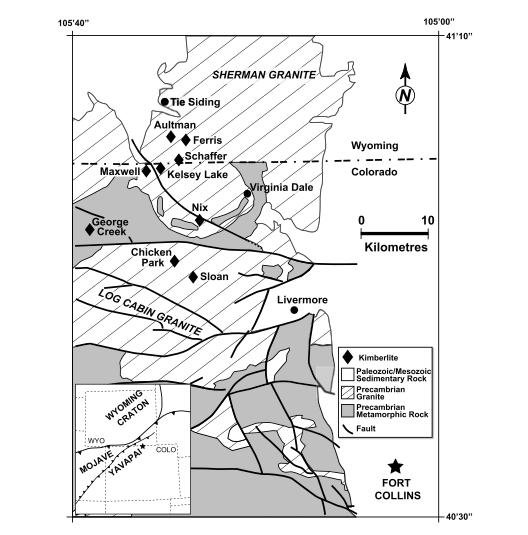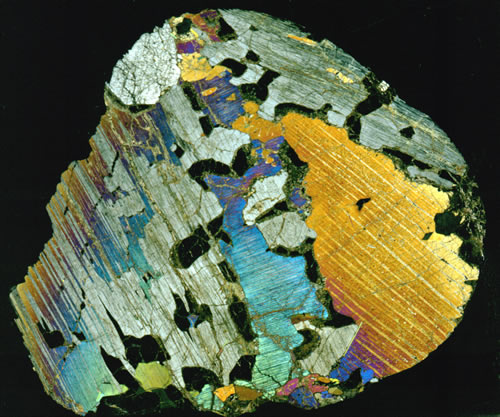- Intro
- Petrology
Colorado – Wyoming State Line Diamonds
by David A. Brown
The diamond-bearing kimberlites
of the Colorado-Wyoming state line province, offer valuable insight into the
physical and chemical conditions in the mantle and the evolution of the craton. The occurrence of diamonds is almost
invariably associated with proximity to Archean cratonal regions (Heaman et al., 2003). Due to their relative impermeability and
non-reactive nature, diamonds are very effective at preserving the chemistry of
their formation conditions. Mineral inclusions
in diamonds are shielded from alteration, and chemical zoneation of the host
grains is also observable. Significant
technological advances have been made recently that make possible very
detailed
spot analysis of these inclusions and chemical zones. Two
especially valuable techniques being Secondary Ion Probe Mass
Spectrometry (SIMS) (described on the Methods page), and the electron microprobe.
The State Line district contains over 100 kimberlitic intrusions, and has produced over 130,000 diamonds including one gemstone of 28.3 carats. In addition to the many diamondiferous kimberlites of the State Line area, there is a non diamondiferous diatreme near Estes Park and another on the slopes of Green Mountain outside of Boulder. Also noteable is the Iron Mountain district, which is approximately 40 miles to the north of the State Line district. All of these occurances are south of the Cheyenne Belt in the Proterozoic Yavapai province, (Lester et al., 2003). There are numerous diatremes further north in Montana and Canada.
The figure at right, (from
Schulze et al., 2008), shows the locations of some of the noteable
kimberlites of the State Line region. The insert shows the
relative position of the Archean Wyoming Craton with the Proterozoic
Mojave and Yavapai provinces.

The figure at left shows a well formed diamond in an eclogitic xenolith.
This sample is from a South African locality.
Image courtesy of Joseph Smyth.
Diamonds
occur in small potassic ultra-basic
intrusive formations known as kimberlite pipes (named after the
classic locality in Kimberley, South Africa; Heaman et al.,
2003). A kimberlite pipe is a type of diatreme, which is often
described as a narrow carrot shaped body of brecciated material
believed to be the result of a gas-driven explosive event. The
alkaline magma associated with diatremes typically has low silica
content, high magnesium and potassium, and abundant volatiles such as
CO2 and H2O (Philpotts and Ague, 2009). The formations
themselves are quite unusual in that the brecciated country rock that
fills the pipe is so thoroughly mixed that lithic fragments originating
from strata well over 1000 meters above the present exposure may be
found juxtaposed with material from lower down. It is noteable
that the fossiliferous Silurian xenoliths found in some of the State
Line pipes represent the only Silurian sedimentary rocks found in
Colorado or Wyoming (Lester et al., 2001). Very little
material is ejected from these eruptions and lava flows are not
produced, suggesting that these events are solely driven by exsolved
gases. There is also an absence of contact metamorphism in the
vicinity of the intrusion. The presence of high pressure mineral
phases such as diamond in kimberlites constrains their depth of
formation to be at least 150 km, and some have even argued for an
origin at the core-mantle boundary (Heaman et al., 2003; Philpotts and
Ague, 2009). Some diamonds have been found to contain inclusions
of majoritic garnet, the stability field of which is in the mantle
transition zone.

There is significant variation in the mineralogy of
kimberlites but they typically contain mafic minerals such as olivine,
clinopyroxene, phlogopite mica, garnet, and ilmenite, as well as a
matrix of calcite, perovskite, phlogopite, and spinel. Accessory
minerals which may be present include apatite, zircon, monticellite,
rutile, serpentine, and various sulfides (Heaman et al., 2003; Page et
al., 2007). Both eclogitic and peridotitic xenoliths are brought
to the surface in kimberlites, and similarly the mineral inclusions in
diamonds are broadly classified as being either eclogitic or
peridotitic. The peridotitic (P-suite) inclusions mainly consist
of olivine, orthopyroxene and Ca-poor/Cr-rich garnet, whereas the
eclogitic (E-suite), inclusions are dominated by Cr-poor garnet and
clinopyroxene and may also include rutile, kyanite, coesite and
sanadine (Kirkley et al., 1991). The peridotitic suite
inclusions can be further subdivided into harzburgitic, lherzolitic,
and wehrlitic groups (Schulze et al., 2008). Peridotitic garnets
are typically Cr-pyrope, and can be classified as; harzburgitic,
lherzolitic, or wehrlitic based on the degree of calcium and chromium
saturation. E-suite garnets are aluminous, have variable FeO,
MgO, and CaO contents, and commonly have Na2O > 0.07% by
weight. Eclogitic pyroxenes, such as omphacite, are also more
sodic (GrÜtter et al., 2004).
The figure above
is a crossed-polars image of an eclogitic xenolith from a south African kimberlite. The isotropic phase is garnet, upper right is
OPX, lower right is CPX, and to the left is an "inverted maajorite"
grain which has exsolved into pyroxenes. Image courtesy of Joseph
Smyth.

The figure at left is a
crossed-polars image of a typical peridotitic (lherzolite)
xenolith. This sample is also South African, the olivine grains
here are quite pristine whereas it is common to observe significant
serpentinization. Image courtesy of Joseph Smyth.
The table below modified from (Schulze et al., 2009) shows chemical analysis of
some peridotitic and eclogitic diamond inclusions from the Kelsey Lake
kimberlite.


Diamonds are relatively impermeable; hence their
inclusions are shielded from alteration and can preserve information
concerning the conditions at the time of formation (Schulze et al.,
2008). It is important to note that the P-suite inclusions in
diamonds (which are more common than E-type) do not have the same
composition as the same minerals found in peridotitic xenoliths of the
same kimberlite. Also, whereas diamondiferous peridotitic
xenoliths are rare, diamonds are commonly found in eclogitic
xenoliths. Various mechanisms have been proposed to explain this
apparent dichotomy in the paragenesis of these minerals. Some
have suggested the diamonds originate from a greater depth than the
xenoliths, others have argued that the P-suite inclusions in the
diamonds could have been derived magmatically from the peridotite
nodules in the presence of volatiles (Harte et al., 1980).
Isotopic zoneation is also observable in many diamonds, and can give
insight into the crystal’s residence time in the mantle and temporal
changes in fluid compositions and the fugacity of gases (Craven et
al., 2009).
The figure to
the right (by Craven et al., 2009) is a cathodoluminescence (CL) image of a
polished diamond section showing distinct zoneation. This type of zoneation
correlates strongly with nitrogen content.